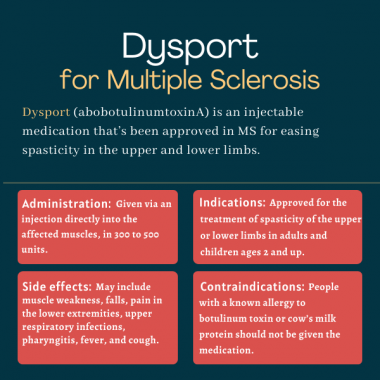FAQs about Dysport in MS
The U.S. Food and Drug Administration approved Dysport in 2015 to treat upper limb spasticity in adults, and in 2017 for lower limb spasticity in adults. Dysport’s use in children with lower limb spasticity was approved in 2016, followed by its approval for children with upper limb spasticity in 2020. The medication originally had been approved by the FDA in 2009 to treat wrinkles across the forehead, called glabellar lines, and for involuntary neck muscle spasms known as cervical dystonia.
While Dysport has not been well-studied in pregnant people, animal studies suggest that it can cause harm to a developing fetus. The medication should only be used during pregnancy if the potential benefit to the patient outweighs the risk to the fetus. Patients on Dysport who become or plan to become pregnant should discuss this topic with their healthcare team.
Alcohol can thin the blood, which may increase the risk of bruising when receiving Dysport injections. It is generally recommended that patients avoid alcohol for at least one or two days before and after each treatment. Patients are advised to talk to their healthcare provider about specific instructions regarding their treatment regimen and alcohol use.
Because Dysport doses and the targeted muscles are tailored to a person’s individual needs, there can be a lot of variability in the time that the medication takes to produce evident benefits. In some patients, spasticity improvements are observed about one week after treatment. These results can last up to 16 weeks or longer.
Neither hair loss nor weight gain was reported as a side effect of Dysport in clinical trials. Patients experiencing these issues are advised to discuss them with their healthcare team.
Related Articles

 Fact-checked by
Fact-checked by 






